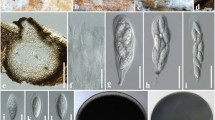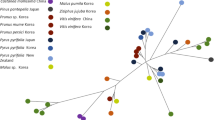Abstract
A few Peziza species have multiguttulate ascospores. Our study of several collections made during the year 2015 allows us to improve our knowledge of these species morphologically and phylogenetically, especially P. retrocurvata. A new species, morphologically close to P. retrocurvata, is also described and illustrated under the name P. retrocurvatoides. Finally, our examination of the type collection of P. brunneoatra proved this to be a distinct species.





Similar content being viewed by others
Notes
Chadefaud (1943) and Berthet (1964: 99) make a distinction between two types of ascogeneous hyphae which produce no croziers, the acrorhynchous type and the aporhynchous type. It is not possible to distinguish them without staining the nuclei. In general, we must consider that the term aporhynchous is only used to specify the absence of croziers.
References
Arora D (1986) Mushrooms demystified, 2nd edn. Ten Speed Press, Berkeley
Avizohar-Hershenzon Z, Nemlich H (1974) Pezizales of Israel. II. Pezizaceae. Israel J Bot 23(3):151–163
Baiano G, Garofoli D, Filippa M (2000) Ascomiceti interessanti del Nord Italia. Fungi Non Delineati 12:1–74
Baral HO (1992) Vital versus herbarium taxonomy: morphological differences between living and dead cells of ascomycetes, and their taxonomic implications. Mycotaxon 44:333–390
Barseghyan GS, Wasser SP (2013) Operculate discomycetes (Pezizales, Ascomycota) of Israel. Koeltz Scientific Books, Königstein
Batra LR, Batra SWT (1963) Indian discomycetes. Univ Kans Sci Bull 44(6):109–256
Benkert D (2010) Seltene und kritische Pezizales-Funde (Ascomycota) aus der Bundesrepublik Deutschland. Z Mykologie 76(1):27–58
Berkeley MJ, Broome CE (1866) XXIII.—Notices of British fungi. Ann Mag Nat Hist Ser 3 18:121–129
Berthet P (1964) Essai biotaxinomique sur les Discomycètes. Thesis, University of Lyon
Beug MW, Bessette AE, Bessette AR (2014) Ascomycete fungi of North America: a mushroom reference guide. University of Texas Press, Austin
Boudier É (1908) Icones mycologicæ, ou iconographie des champignons de France, principalement Discomycètes. Livraison 17. Klinsieck, Paris
Cabero J, Alvarado P, Healy R, Moreno G (2016) Luteoamylascus aculeatus (Pezizomycetes, Pezizaceae): a new genus and species near the Pachyphlodes–Amylascus lineage. Mycol Prog 15:33
Chadefaud M (1943) Sur les divers types d’éléments dangeardiens des Ascomycètes, et sur la formation des asques chez la Pézize Pustularia catinus. Rev Sci 81:77–80
Cooke MC (1875) Mycographia, seu icones fungorum. Vol I. Discomycetes. Part 1. Williams and Norgate, London
Dennis RWG (1960) British cup fungi and their allies. The Ray Society, London
Desmazières JBHJ (1836) Notice sur quelques Cryptogames nouvelles qui ont été publiées, en nature, dans les fascicules XIV–XVII des Plantes cryptogames de France. Ann Sci Nat Bot Sér II 6:242–247
Donadini JC (1981) Le genre Peziza dans le sud-est de la France, avec clef du genre pour la France. Thesis, Université de Provence
Donadini JC (1985) [1984] Le genre Peziza dans le sud-est de la France. Complément (1) avec extension à l’Europe. Bull Soc Linn Prov 36:153–166
Engel H, Svrček M (1983) Pilzneufunde in Nordwestoberfranken und seinen angrenzenden Gebieten 1982, II (Ascomyceten). Pilzflora Nordwestoberfrankens 7:35–60
Gardes M, Bruns TD (1993) ITS primers with enhanced specificity for basidiomycetes—application to the identification of mycorrhizae and rusts. Mol Ecol 2(2):113–118
Gillet CC (1879) Les Discomycètes. Champignons de France. Chez l’auteur, Alençon
Hansen K, Sandal SK, Dissing H (1998) New and rare species of Pezizales from calcareous woodlands in Denmark. Nord J Bot 18(5):611–626
Hansen K, Læssøe T, Pfister DH (2001) Phylogenetics of the Pezizaceae, with an emphasis on Peziza. Mycologia 93(5):958–990
Hansen K, LoBuglio KF, Pfister DH (2005) Evolutionary relationships of the cup-fungus genus Peziza and Pezizaceae inferred from multiple nuclear genes: RPB2, β-tubulin, and LSU rDNA. Mol Phylogenet Evol 36(1):1–23
Huhtinen S (1984) Additions to the ascomycetous flora of the Canadian North. Karstenia 24:1–11
Kar AK, Pal KP (1968) Peziza multiguttulata, a new name for Orbilia obscura. Mycologia 60(4):964–966
Küppers H (1981) DuMont’s Farbenatlas. DuMont Buchverlag, Köln
Le Gal M (1941) Les Aleuria et les Galactinia. Rev Mycol (Paris) 6:56–82
Lonati G (1994) Funghi rari o poco conosciuti, Peziza ionella Quélet–Peziza brunneoatra Desmazières. Boll AMER 32:3–8
McNeill J, Barrie FR, Buck WR, Demoulin V, Greuter W, Hawksworth DL, Herendeen PS, Knapp S, Marhold K, Prado J, Prud’homme van Reine WF, Smith GF, Wirsema JH, Turland NJ (2012) International Code of Nomenclature for algae, fungi, and plants (Melbourne Code). Regnum Vegetabile 154. Koeltz Scientific Books, Königstein
Migula W (1913) Kryptogamen-Flora von Deutschland, Deutsch-Österreich und der Schweiz. Band III. Pilze 3. Teil 2. Abteilung. Friedrich von Zerschwitz, Gera
O’Donnell K, Cigelnik E, Weber NS, Trappe JM (1997) Phylogenetic relationships among ascomycetous truffles and the true and false morels inferred from 18S and 28S ribosomal DNA sequence analysis. Mycologia 89(1):48–65
Pfister DH (1985) A bibliographic account of exsiccatae containing fungi. Mycotaxon 23:1–139
Rehm H (1896) Die Pilze Deutschlands, Oesterreichs und der Schweiz. III. Abtheilung: Ascomyceten: Hysteriaceen und Discomyceten. Eduard Kummer, Leipzig
Ronquist F, Huelsenbeck JP (2003) MrBayes 3: Bayesian phylogenetic inference under mixed models. Bioinformatics 19(12):1572–1574
Seaver FJ (1906) Iowa Discomycetes. Bull Lab Nat Hist State Univ Iowa 6(2):41–163
Seaver FJ (1928) The North American cup-fungi (Operculates). By author, New York
Stamatakis A (2006) RAxML-VI-HPC: maximum likelihood-based phylogenetic analyses with thousands of taxa and mixed models. Bioinformatics 22(21):2688–2690
Svrček M (1981) A revision of species of the genus Peziza Dill. ex St-Amans, described by J. Velenovský. II. Česká Mykologie 30(3–4):135–142
Tamura K, Peterson D, Peterson N, Stecher G, Nei M, Kumar S (2011) MEGA5: molecular evolutionary genetics analysis using maximum likelihood, evolutionary distance, and maximum parsimony methods. Mol Biol Evol 28(10):2731–2739
Van Vooren N (2014) Contribution à la connaissance des Pézizales (Ascomycota) de Rhône-Alpes. 2e partie. Cah FMBDS 4:1–172
Velenovský J (1934) Monographia Discomycetum Bohemiae. By author, Prague
Vilgalys R, Hester M (1990) Rapid genetic identification and mapping of enzymatically amplified ribosomal DNA from several Cryptococcus species. J Bacteriol 172(8):4238–4246
White TJ, Bruns T, Lee S, Taylor JW (1990) Amplification and direct sequencing of fungal ribosomal RNA genes for phylogenetics. In: Innis MA, Gelfand DH, Sninsky JJ, White TJ (eds) PCR protocols: a guide to methods and applications. Academic Press, New York, pp 315–322
Acknowledgements
We acknowledge gratefully the following persons for having shared their material, photographs, documentation or data: Daniel Daneyrolles, Zuzana Egertova, Jörg Gilgen, Mikel Tapia, Bernard Rivoire, Enrique Rubio and Jürgen Schnieber. Bart Buyck (PC, Muséum national d’histoire naturelle, Paris, France) is acknowledged for his loan. Christian Lange (Statens Naturhistoriske Museum, Copenhagen, Denmark) is warmly thanked for his review of the type material of Peziza retrocurvata. We also thank Pablo Alvarado (ALVALAB) for sequencing the material and for the phylotree. Chris Yeates is warmly thanked for the English review of the manuscript.
Author information
Authors and Affiliations
Corresponding author
Additional information
Section Editor: Teresa Itturiaga and Marc Stadler
This article is part of the Special Issue on ascomycete systematics in honour of Richard P. Korf who died in August 2016.
Rights and permissions
About this article
Cite this article
Van Vooren, N., Dougoud, R. & Fellmann, B. Contribution to the knowledge of Peziza with multiguttulate ascospores, including P. retrocurvatoides sp. nov.. Mycol Progress 17, 65–76 (2018). https://doi.org/10.1007/s11557-017-1335-8
Received:
Revised:
Accepted:
Published:
Issue Date:
DOI: https://doi.org/10.1007/s11557-017-1335-8




